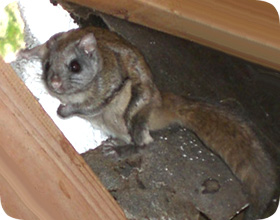- info@wildlife-removal.com
Call us for help in your town
Wildlife Removal Education
How to Get Rid of Flying Squirrels in Your Attic
Need squirrel removal in your hometown? We service over 500 USA locations! Click here to hire us in your town and check prices - updated for year 2020.
 Flying Squirrels are usually classified as a pest species because they love to live in attics, they are nocturnal, and they live in colonies of several animals. Read more about flying squirrels. The most common complaints include the following:
Flying Squirrels are usually classified as a pest species because they love to live in attics, they are nocturnal, and they live in colonies of several animals. Read more about flying squirrels. The most common complaints include the following:
- Scurrying in attic at night
- Odor from large colony in attic
- Chewing on wood outside home
- Chewing on wires in attic
For these reasons, many people wish to have nuisance Flying Squirrel trapped and removed.
Need professional help? Click here for my Nationwide List of Flying Squirrel Trappers
How To Get Flying Squirrels Out Of Your Attic
Flying squirrels are small and clever rodents that will spend the majority of their lives going from tree to tree when they are living in their natural habitat. However, there are a number of instances where flying squirrels can find their way into a domestic property, and when this happens they will usually have found their way into the attic or roof cavity of the property. There are a number of issues that can be caused by such an infestation, including hygiene and health issues as well as the scratching and scampering noise that will often be heard from the attic. Read the guide Can You Use Repellent to Remove Flying Squirrels from the Attic? or Ways To Prevent Flying Squirrels.
Identifying The Problem
It can often be difficult to tell the difference between a regular squirrel infestation and having flying squirrels in the attic unless you actually go into the attic to see the animals. Flying squirrels will generally be smaller than the Eastern Gray squirrels that are such a problem for many people, but flying squirrels will also live in much greater numbers. If you're not able to access the attic space yourself, then a visual examination of the soffits and boards around the base of your roof will often indicate a number of holes that could be used by the flying squirrels as entry and exit points.
Once you have confirmed that it is an infestation of flying squirrels, then there are a couple of options that can be used to try and get rid of these animals.
Dealing With The Flying Squirrels
The most popular option used by professionals dealing with a flying squirrel infestation is to seal the roof cavity and to make sure there is only one or two exit or entry points that can be used. Once these have been sealed, then a one-way exit can be put in place. Some of the wildlife experts will actually have the exits leading into a repeater trap to actually catch all of the animals, while others will simply allow the squirrels to leave the property, but as they cannot get back in they will have to go elsewhere.
Placing a trap to catch all of the flying squirrels has the added benefit of being able to move the flying squirrels as a colony, as they can often be split up when they all leave the attic space intermittently.
Once you are satisfied that all of the squirrels have been captured, then they should be taken at least ten miles away from your property and then released in an area of deciduous woodland away from domestic properties. Some states will have laws about releasing pest animals into the wild, and they may insist that the flying squirrels are actually taken to a state facility to be dealt with. It is also worth going in to the attic space to check the area so that you can be certain there are no flying squirrels or babies remaining in the attic. Read the guide How can You Kill A Flying Squirrel?
Sealing The Attic
The most important thing to do once the flying squirrels have been removed is to seal the attic to make sure that no others can get into the attic. Flying squirrels are often animals that will follow where others have gone, so if one animal can find their way into the attic then others can too unless the entry points are sealed.
For this job it is often best to invite a professional to examine the attic and to repair any holes or weak points in the roof space where more flying squirrels could enter. It is also wise to have a professional decontaminate the attic to prevent any health issues being caused by the feces and urine of the flying squirrels.
For more info, go back to my main Flying Squirrel Removal page. Read the guides Best Ways to Trap or Exclude Flying Squirrels and Ways to Tell if There is A Flying Squirrel in Your Attic.


















